Download Printable PDF
This paper is intended for educational and discussion purposes,
only. Copyright 2017, Steven F. Wille.
Zero
Sum Games
Agile vs.
Waterfall Project Management Methods
By Steven F. Wille, PMP, with Michael S. Wille, PMP, CSM
Agile software development is
hitting the mainstream and is starting to displace the traditional
project management method known as waterfall. It is useful to step
back to see what we are gaining and what we are losing with each
approach. We will show that picking one or the other approach may
be a zero sum game and we will offer an alternative approach that is
non-zero sum.
 Letís
start with some definitions. In a
zero sum game, each participant's gain or
loss is balanced by the losses or gains of the other participants.
If we assign a numeric score of 1 for winning and -1 for losing, the
sum total will always be zero because there is always a winner and a
loser. We can play the game a thousand times and the sum score will
still be zero. Letís
start with some definitions. In a
zero sum game, each participant's gain or
loss is balanced by the losses or gains of the other participants.
If we assign a numeric score of 1 for winning and -1 for losing, the
sum total will always be zero because there is always a winner and a
loser. We can play the game a thousand times and the sum score will
still be zero.
 Waterfall
is a sequential software development processes, in which progress is
seen as flowing steadily through the project phases. The water
flows in one direction symbolizing that once a phase is completed
you donít get to go back to make changes. This is because changes
are expensive late in a project time line as compared to getting
things right in the design phase. Overall project efficiency is the
goal of waterfall development. Waterfall
is a sequential software development processes, in which progress is
seen as flowing steadily through the project phases. The water
flows in one direction symbolizing that once a phase is completed
you donít get to go back to make changes. This is because changes
are expensive late in a project time line as compared to getting
things right in the design phase. Overall project efficiency is the
goal of waterfall development.
Our source for defining
traditional waterfall project management is the Project Management
Instituteís book,
A Guide to the Project Management Body of Knowledge (PMBOK Guide).
This was first published in the 1990s. It documents good practices
in project management. The traditional phases of a project are
initiating, planning, executing, controlling,
and
closing.
PMBOK covers ten knowledge areas with
particular attention given to
scope,
time, and
cost. These are known as the triple
constraints. It is easier to accomplish two of the triple
constraints if you donít care about the third. For example, it is
easier to be on time and on budget if you donít care about scope.
The hard thing to do is to be on time, on budget, with the full
scope of features promised. Effective project management is all
about being on time, on budget, and with full scope.
 Take
note that the for all PMOBK knowledge areas
management is a key word. There are many
definitions of management. We will define it as the opposite of
unmanaged, chaotic, and out of control. Take
note that the for all PMOBK knowledge areas
management is a key word. There are many
definitions of management. We will define it as the opposite of
unmanaged, chaotic, and out of control.
The dictionary definition of
agile is, ďmarked by ready ability to move
with quick easy grace, <an
agile dancer>. Ē The second definition
is ďhaving a quick resourceful and adaptable character, <an
agile mind>Ē (merriam-webster.com) . The
theme here is flexibility and speed, with resourcefulness and
adaptability.
We will define agile project
management as it is expressed in the
Agile Manifesto, published in 2001. This
is a brief document containing four high level strategies and twelve
principles. You can find this on line and print it yourself.
Manifesto for Agile Software Development
We are uncovering better ways
of developing software by doing it and helping others do it. Through
this work we have come to value:
1. Individuals
and interactions over
processes and tools.
2. Working
software over comprehensive
documentation.
3. Customer
collaboration over contract
negotiation.
4. Responding
to change over following a
plan.
That is, while there is value
in the items on the right, we value the items on the left more.
We follow these principles:
1. Our
highest priority is to
satisfy the customer through
early and continuous delivery of valuable
software.
2. Welcome
changing requirements, even late in development.
Agile processes harness change for the customer's competitive
advantage.
3. Deliver
working software frequently, from a couple
of weeks to a couple of months, with a preference to the shorter
timescale.
4. Business
people and developers must
work together daily throughout the
project.
5. Build
projects around
motivated individuals. Give them the
environment and support they need, and trust them to get the job
done.
6. The
most efficient and effective method of conveying information to and
within a development team is
face-to-face conversation.
7. Working
software is the primary
measure of progress.
8. Agile
processes promote sustainable development. The sponsors, developers,
and users should be able to
maintain a constant pace indefinitely.
9. Continuous
attention to
technical excellence and good design
enhances agility.
10.
Simplicity--the art of maximizing the
amount of work not done--is essential.
11. The
best architectures, requirements, and designs emerge from
self-organizing teams.
12. At
regular intervals, the
team reflects on how to become more
effective, then tunes and adjusts its behavior accordingly.
(highlighting added)
http://agilemanifesto.org/
© 2001, the above authors
this declaration may be freely copied in any form,
but only in its entirety through this notice.
 Rather
than being like a peaceful waterfall, agile projects are like
rafting down the rapids. Change can happen any time, even late in
the process. Watch where you are going and think fast! Rather
than being like a peaceful waterfall, agile projects are like
rafting down the rapids. Change can happen any time, even late in
the process. Watch where you are going and think fast!
Now that we have defined the
terms, letís explore the strategy for playing a zero sum game.
Consider flipping a coin. There are two, and only two outcomes. On
each throw you have a 50% chance of winning regardless of which you
call, heads or tails. No strategy is required because your choice
makes no difference when there is a 50% chance of winning and
losing.
When faced with two choices,
it is helpful to ask if there is a third option. This opens things
up to new possibilities. Rock paper scissors is a zero sum game
with three options, and it requires a little bit of strategy.
 Two
people play. Each person makes the sign for a rock, paper, or
scissors. If both pick the same option, the score is zero and you
replay. If they are different, then the following rules are
followed. Two
people play. Each person makes the sign for a rock, paper, or
scissors. If both pick the same option, the score is zero and you
replay. If they are different, then the following rules are
followed.
∑ Scissors
cuts paper, paper loses.
∑ Rock
blocks scissors, scissors loses.
∑ Paper
covers rock, rock loses.
For each option, there is a way to win and way to lose.
The worst strategy is to play
the same option every time. Your opponent will soon figure out how
to beat your strategy. The best strategy is to be totally
unpredictable.
 The rock symbolizes rock solid management where you are in
compliance with all regulations and expectations. Your decisions
are financially sound with the required return on investment
balanced by an acceptable level of risk. Processes and procedures
are repeatable, and hopefully, show continuous improvement.
The rock symbolizes rock solid management where you are in
compliance with all regulations and expectations. Your decisions
are financially sound with the required return on investment
balanced by an acceptable level of risk. Processes and procedures
are repeatable, and hopefully, show continuous improvement.
 Paper
symbolizes the people side of project management. Keep in mind that
you can manage processes, but people are not processes. You must
lead people. Feelings matter. You must pay attention to teamwork
when leading a group of people and you must follow cultural and
social rules. Confounding all of this is the part that politics
play in any organization infested with human beings. Paper
symbolizes the people side of project management. Keep in mind that
you can manage processes, but people are not processes. You must
lead people. Feelings matter. You must pay attention to teamwork
when leading a group of people and you must follow cultural and
social rules. Confounding all of this is the part that politics
play in any organization infested with human beings.
 The
scissors represents human ingenuity. People are always finding new
ways to do things. Sometimes new ways drive out old, disrupting the
old order. The scissors lets people cut away from the past to focus
on the present and future. It can look chaotic, but order often
emerges from chaos. With the scissors you can change the shape of
things. With the rapid change in technology we are seeing in the 21st
century, flexibility is essential for survival. The
scissors represents human ingenuity. People are always finding new
ways to do things. Sometimes new ways drive out old, disrupting the
old order. The scissors lets people cut away from the past to focus
on the present and future. It can look chaotic, but order often
emerges from chaos. With the scissors you can change the shape of
things. With the rapid change in technology we are seeing in the 21st
century, flexibility is essential for survival.
Another way to look at the
scissors is as a means to get things done, even in an unpleasant
way. A surgeon may have to cut you to heal you. A carpenter has to
cut the wood to make the structure. The artist has to chip away the
stone to liberate the statue that is inside.
Even with three options,
letís recognize that we are still playing a zero sum game. Each
option can block another option. For example, a rock solid
organization can block innovation. Rock solid is good, but not all
the time. Sometimes it is a path to going out of business because
the world has changed and the market has moved on before the
organization can catch up.
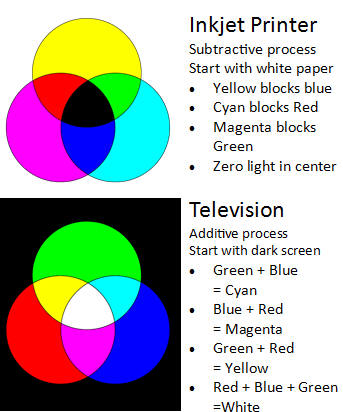 Letís
look at this from the perspective of filters that block light. Cyan
blocks red and lets the green and blue pass. Magenta blocks green
and lets the red and blue pass. Yellow blocks blue and lets red and
green pass. If you stack all the filters together, no light
passes. This is how your
ink jet printer works. You start with
white paper that reflects every color. As you spray on cyan,
magenta, and yellow ink, you block light to create many colors. If
you spray on all three colors, you get black where no light reflects
from the white paper. Letís
look at this from the perspective of filters that block light. Cyan
blocks red and lets the green and blue pass. Magenta blocks green
and lets the red and blue pass. Yellow blocks blue and lets red and
green pass. If you stack all the filters together, no light
passes. This is how your
ink jet printer works. You start with
white paper that reflects every color. As you spray on cyan,
magenta, and yellow ink, you block light to create many colors. If
you spray on all three colors, you get black where no light reflects
from the white paper.
The additive color process is
different. Imagine a dark room where you shine red, green, and blue
lights on the wall. Where they all shine together, you see white.
Where they mix, you see other colors. This is how your
television works. Red, green, and blue
lights work together to create a full color, high definition
picture.
Lets look at this zero sum
game from the perspective of the additive light process in order to
turn it into a non-zero sum game. Instead of thinking rock, paper,
or scissors, think rock, paper
and scissors. Imagine a team where
everyone is required to be a rock. There would be no room for human
feelings or human ingenuity. If you have representation from all
three, and encourage rather than blocking other perspectives, your
opportunity for sustained success increases substantially.
Not everyone in my family is
in a technology professional. Some work in the medical field. I
heard my wife and my daughter talking about the pressures of working
in the medical profession. That discussion was the inspiration for
this paper. In the age of for-profit hospitals you must be customer
friendly so that people will come to your hospital to spend their
unlimited health care dollars provided by insurance companies or the
government. In addition you must be in compliance with corporate
policies, insurance policies, and government regulations. In
addition, patient care should be your primary concern. In an ideal
world, there would be time and energy for all three, but in the less
than ideal world, something has to give.
 Hospital
employees can be measured on compliance and customer friendliness,
but it is hard to measure the real job of patient care.
Consequently, there is pressure for these two at the expense of the
third. In addition, corporations find it more profitable to have
less staff, further increasing the pressure. The most profit would
come from compliance and customer friendliness with just adequate
patient care. This would fill the beds and the compliance part
would assure minimally adequate patient care. Hospital
employees can be measured on compliance and customer friendliness,
but it is hard to measure the real job of patient care.
Consequently, there is pressure for these two at the expense of the
third. In addition, corporations find it more profitable to have
less staff, further increasing the pressure. The most profit would
come from compliance and customer friendliness with just adequate
patient care. This would fill the beds and the compliance part
would assure minimally adequate patient care.
Back in the 20th century some
large organizations survived and thrived by being rock solid with
employees fully aligned with corporate goals. Individual ingenuity
was limited to the people who had the appropriate roles. Everyone
else had to stay in line. It was a system that worked well in the
industrial age.
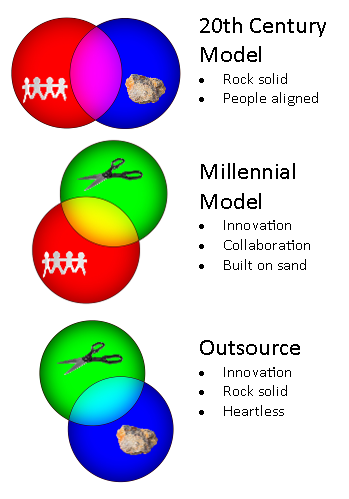 We
are in the 21st century and technology is changing rapidly. If you
stand still you fall behind. Organizations need human ingenuity and
collaboration to get ahead of the competition. Ingenuity and
collaboration are essential for accomplishing that goal. This
suggests the scissors and paper may be more appropriate for the 21st
century organization. We
are in the 21st century and technology is changing rapidly. If you
stand still you fall behind. Organizations need human ingenuity and
collaboration to get ahead of the competition. Ingenuity and
collaboration are essential for accomplishing that goal. This
suggests the scissors and paper may be more appropriate for the 21st
century organization.
Dan Lyons, in
Disrupted, My Misadventure in the Start-Up Bubble,
wrote about what it was like to be a 52 year old, seasoned
journalist, working in a startup where most employees were in their
20s, many right out of college. The company,
Hubspot, had a $100 million in venture
capital and Lyons was offered stock options for a possible initial
public offering (IPO). The book was a humorous read as Lyons
described the fraternity like culture. It was anything but the rock
solid environment described in this paper. When the company went
public in 2014, it was losing money, $34 million according its S-1
document with the U.S. Securities and Exchange Commission. As of
the 4th
quarter of 2016, it was still losing millions of dollars. Even with
the losses, the founders made a lot of money when the company went
public. You can see why Lyons references the
start-up bubble in the book title. You
can make your own conclusions about the value of a company that is
not rock solid and has never made a profit.
The other way to survive in
the 21st century is to outsource everything, leaving little to no
work for local employees. This is a picture of an organization
without a heart. It may be profitable, rock solid, and innovative
even though it has no care for people.
In the traditional waterfall
world the goal is to deliver everything promised on time and on
budget. The project team is in full alignment with the
organizationís goals and the project is managed in accordance with
the organizationís standards. We see this as rock solid with a
highly organized team.
In the agile world the goal
is to work within the time frame and budget to deliver what can be
delivered when it can be delivered. There is high collaboration
between the project team and the product owners with a great deal of
flexibility in how the project team works to make this happen.
The outsource option is always
out there and cannot be forgotten, but we will not be focusing on
that option. We will focus on what is being delivered and how the
internal project team interacts with the product owners.
Waterfall and agile
approaches appear to be at odds with each other and could be seen as
mutually exclusive. Inder Sidhu, in the book,
Doing Both:
How Cisco Captures Today's Profit and Drives Tomorrow's Growth,
pointed out that much of Ciscoís success came from doing
both when faced with an either/or decision. The cover of his book
shows the Golden Gate Bridge. Originally, the bridge was going to
look like any other bridge that carried cars over an expanse of
water. When faced with a decision to focus on the utility of the
bridge or to make it a work of art, they did both. The beauty of
the bridge makes it a landmark that immediately identifies it with
San Francisco. Sidhu says it is easy to settle for one option, but
it is better to do both. Many companies focus on existing markets
and fail to reach new markets. Other companies focus on the new
markets at the expense of existing ones. Cisco did both. The added
marginal cost of doing both is often small compared to the initial
cost of doing one.
How do you do both? Take out
the
but and insert an
and when you are considering one choice
over another. For example if you have a great idea and another
person has a competing idea, you might say, ďI heard what you said,
but my option will take us in a new
direction to open up more possibilities.Ē That puts you in an
adversarial position where one of you will win and one will lose.
The alternate is to say, ďI heard what you said,
and my other option will take us in a new
direction to open up more possibilities.Ē Now both options are up
for discussion and there might be some middle ground. Often things
that at first appear to be mutually exclusive are not. The problem
is we focus too much on one option and fail to accommodate others.
Best practice
infers the one best way to do any particular task. This is can be
zero sum because it is all or nothing, right or wrong. There are
often multiple ways to accomplish a task with equally good results.
This simple way to get past zero sum is to focus on good practices
rather than the one best practice. Good practices can be good
enough to get the job done, allowing for individual creativity in
finding a better way. It should be noted that waterfall and agile
methodologies both have best practice advocates. Formal training is
available for both methods. Many organizations are place great
emphasis on doing one method the right way. The problem with this
is that people get things done. Methodologies are just tools that
people use.
Common practices
or
good practices
would
be non-zero terms to describe what we can learn from a methodology,
but the best method for a particular project can vary. Rules are a
zero sum way to get compliance with best practices. Options are a
non-zero sum path to blending human ingenuity with rock solid. The
real goal is to get the job done. A blended approach makes room for
people to focus on the end goal and find a path to success.
Letís try blending the rock,
paper, and scissors. The rock and scissors are both task oriented
while paper is people oriented. How the team is organized often
depends on the task. Most projects have scissors and rock tasks.
The team will function better if is organized to do both.
Alignment - Collaboration
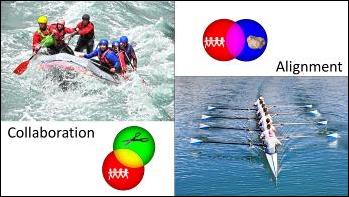 We
have already touched on collaboration and alignment. Consider a
rowing team on relatively flat water. The rowing team is most
efficient if everyone is aligned, doing the exact same thing at the
exact same time. To accomplish this, in the crew there is a
coxswain who sits in the back facing the front. The coxswain is
responsible for steering the boat, and coordinating the power and
rhythm of the rowers who are facing the back and cannot see where
they are going. We
have already touched on collaboration and alignment. Consider a
rowing team on relatively flat water. The rowing team is most
efficient if everyone is aligned, doing the exact same thing at the
exact same time. To accomplish this, in the crew there is a
coxswain who sits in the back facing the front. The coxswain is
responsible for steering the boat, and coordinating the power and
rhythm of the rowers who are facing the back and cannot see where
they are going.
Next, consider a rubber raft
running the rapids in fast moving, dangerous water. People must
coordinate their efforts, but due to rapidly changing conditions
they must be flexible. Everyone faces the front and pays attention
to where the raft is going. There is no coxswain keeping time.
Instead, the leader is yelling out what needs to be done. Can one
athlete do both? Of course, but not at the same time. When rowing,
alignment counts. When paddling, experienced judgment counts. Some
aspects of a project require an aligned team and other aspects
require experienced judgment with a great deal of flexibility. The
mistake is to be a coxswain when a different kind of leadership is
needed.
Clear roles - Ambiguous roles
Sometimes we need clear roles and other times
we need ambiguity with self-organizing teams. It is great to
identify who is responsible for what, and it is also great to give
people freedom rather than putting them in a predefined box. If you
want innovation, you need ambiguity. If you want predictability and
control you need clarity. Can you do both on one project? Of
course you can. Some tasks need great clarity and other tasks
require creativity. Too much control kills creativity.
The agile principles that
address this are:
4. Business people and developers must
work together daily throughout the
project.
6. The most efficient and effective method of
conveying information to and within a development team is
face-to-face conversation.
11. The best architectures, requirements, and
designs emerge from
self-organizing teams.
By contrast, traditional
projects usually clarify roles, often through the
RACI Matrix:
∑ Responsible
(Persons who will be performing the work)
∑ Accountable
(Person who is ultimately held accountable)
∑ Consulted
(Subject matter experts)
∑ Informed
(Communication is one-direction)
Requirements - User stories
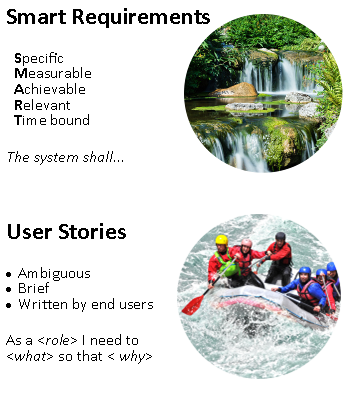 Project
scope defines what needs to be accomplished. In the waterfall
world, requirements define what will be done.
SMART requirements are
Specific,
Measurable
Achievable,
Relevant,
and
Time
bound. There is to be no deviation from
these specific requirements without formal approval, even if you
could do something better, faster, and at lower cost. You may not
deviate without approval. Project
scope defines what needs to be accomplished. In the waterfall
world, requirements define what will be done.
SMART requirements are
Specific,
Measurable
Achievable,
Relevant,
and
Time
bound. There is to be no deviation from
these specific requirements without formal approval, even if you
could do something better, faster, and at lower cost. You may not
deviate without approval.
In the agile world there is
intentional ambiguity in defining what needs to be done. User
stories are commonly used and they are written from the userís
perspective. They define what is needed and why it is needed. The
agile team is expected to focus on
why when viewing the user story and figure
out how to best accomplish this objective. There is room for
creativity. Ideas on accomplishing the goal better, faster, and at
lower cost are always welcome.
User stories and requirements
can both be used for quality assurance testing. Requirements are
specific enough to be inserted directly into the test plan.
Acceptance criteria are frequently included in the user story and
also can be inserted into the test plan. Here are some examples:
Requirements
1. The
system shall interact on-line with Mastercard, Visa, American
Express, and Discover cards.
2. 1. The
system shall transmit name, address, phone, purchase amount, credit
card number, and expiration date to the credit card company.
3. The
system shall record the authorization from the credit card company.
4. The
system shall comply with PCI security requirements for credit cards.
User Story
As a sales agent, I need to accept credit cards over the phone and
verify the information so that I can complete the purchase.
Acceptance Criteria
1. This works with all credit cards accepted by our company.
2. There is a way to verify the information with the credit card
organization.
3. Customer data is kept secure.
The
International Institute of Business Analysis (IIBA)
has recognized the evolving face of how
requirements can be written. The current version of the BABOK says,
ďThe nature of the representation may be a document (or set of
documents), but
can vary widely depending on the
circumstances.Ē Clearly you can do both, depending on what is
needed for the project. If you know exactly what you want, go for
requirements. If you are interested in what you think you want, or
something better, then go for user stories. There is no reason not
to use both on the same project, depending on the specific needs to
be accomplished.
Timing: RandomóSequential
 Timing
is everything. Ask any musician and you will learn that timing
makes the music come alive. The same is true with projects. One of
the fundamental differences between agile and waterfall projects is
timing. It is also one of the areas driving the greatest division
of opinion. What is the right timing for a project task?
Waterfall calls for sequential, step-by-step timing with an emphasis
on the critical path which is identified during the planning
phase. Changes require formal approval with the expectation that
the change will affect the project cost and schedule. Timing
is everything. Ask any musician and you will learn that timing
makes the music come alive. The same is true with projects. One of
the fundamental differences between agile and waterfall projects is
timing. It is also one of the areas driving the greatest division
of opinion. What is the right timing for a project task?
Waterfall calls for sequential, step-by-step timing with an emphasis
on the critical path which is identified during the planning
phase. Changes require formal approval with the expectation that
the change will affect the project cost and schedule.
Agile promotes more random
timing with a focus on the next deliverable, along with creating a
minimum viable product. Changes to requirements, even late in
development are welcome.
Opinions on the best timing
often reflect personal preferences rather than project needs.
Anthony Gregorc noticed difference in how we perceive time and saw
preferences in how we handle timing. In
An Adultís Guide to Style he identified
predictable patterns. He took no stand on what is best, just that
there are common differences in style.
We can separate people into
groups. Some people lean toward what Gragorc calls
random and some toward
sequential. This is a continuum, with
relative few at either extreme, but the extremes are useful for
defining the continuum.
People who lean toward
sequential timing see time in terms of discrete units, such as
minutes, hours, days, and years. Time always moves forward from
past to present to future. The clock never stops and never goes
backwards. This pattern calls for step-by-step tasks that lead
directly to the completion of a goal. People at the extreme of
sequential are quite bothered when something is done in the wrong
order. To them it destroys the whole process. They think you
should take your time on each task to do it right the first time.
On the other side of the
continuum, there are people who see time as
now. Our graphic shows a stopwatch. If
something does not work, stop the clock and try again. Doing it
right the first time makes no sense. Until they have tried several
times, they donít know what is
right. Rather than a linear progress of
activities, the random style allows work in several dimensions at
once. This may look random to a linear thinker, but to the random
style person it is simply living in the
now timeframe and working in several
dimensions at once.
After many years of managing
project teams I have seen more conflict resulting from differences
in of timing than any other source. It is one of the
fundamental reasons some people have a difficult time in either an
agile or waterfall environment. One day I got a call from my
son who was in his final semester of college. He said he was
struggling with a required
class. The class was analysis and design, which was part of his
information systems major. I asked what the problem was. He said
the professor wanted him to write the design before writing the
software code. I stopped him right there and said that half of the
experienced software developers I have known have the same problem.
I tell them to write the code but donít tell anyone. After that,
write the design, which is just a description of the code they
wrote. The sequential thinkers cannot handle things done out of
order. I suggested to may son that he write the code, but not tell
the professor. Give her the design before showing the program. At
a reasonable time later, present the program. Then tell her how
wonderful it was to have a design before writing the code.
People who live in
now need to maximize
now, and that means jumping right in.
They have no problem stopping the clock and starting over. An
excellent software developer on one of my teams, Dave, often went
through many iterations, starting over with different approaches
until something worked. I respected Daveís approach, but when he
worked on another development team that was much more structured and
sequential, Dave was not respected and not well liked. Dave was my
go-to person but he simply could not function in the other teamís
sequential environment. It was
interesting that the other team was using the agile methodology, but
they were anything but flexible, making them less than agile.
How do you do both? A better
question would how do you accommodate both styles? Chances are, you
have a significant number of both styles on your team. I lean
toward the random side and I tend to frustrate the sequential style
people. They work real hard to get each step exactly right, and
then I do a restart which invalidates the work they have done. I
learned that when I am working with a sequential worker, I need to
do my homework and think through exactly what I want. When I work
with the random workers, it is best if I speak of the end goal in
general terms and leave them alone. From time to time I check in to
see if they are delivering approximately what I want.
If you are a hard core agile
project manager, you will probably frustrate the people who have a
need to work sequentially. If you are a hard core waterfall project
manager you will probably frustrate the people who have a need to be
more random. You must do both if you want everyone to do what they
do well. If you do one or the other, exclusively, you will be half
as effective overall. It is like playing rock, paper, scissors and
always being a rock or always being a scissors. This is the
subtractive zero sum process rather than the additive non-zero sum
process.
It is possible to do both
even if your organization has a strong bias for one approach. I
once worked for a very large financial company. Because we were
managing other peopleís money, we had to do things right, all the
time. The application development culture at the company was
waterfall and most of the departments operated that way. The group
I was with practiced waterfall project management, but did it in an
agile way, long before agile practices became mainstream.
We practiced these agile
principles:
1. Our
highest priority is to satisfy the customer through early and
continuous delivery of valuable software.
2. Welcome
changing requirements, even late in development. Agile processes
harness change for the customer's competitive advantage.
The other departments did
annual planning, starting in September with business groups
submitting project requests for the following year. The technology
people did estimates and the management group set priorities.
Senior management drew a line on the priority list and the items at
the top became the measurable goals for the year. It was an
orderly, step-by-step process and it was perfectly aligned with
business priorities. The plan was formally updated quarterly, and a
brand new plan created annually. Once a quarter all items that were
scheduled for the quarterly release went into integrated testing for
30 days. No changes were allowed during this 30 day period without
formal permission.
Our department did continuous
planning. Business groups could submit requests at any time. There
was a meeting every Friday when they could explain their
priorities. Everything that went through the Friday meeting went
into the request database. The request backlog was assumed to be
multi-year. Some things might never be done, but they were worth
keeping in sight. Every Tuesday, the technology management team met
to review the request database. Some projects were in process and
near completion, some projects were just starting, and most project
just stayed on the list with no action. Every Thursday we went live
with any projects that had the proper testing and business signoff.
Life changed when our group
started reporting to the senior manager of the other groups. It was
a painful transition to go to annual planning rather than continuous
planning. We learned how to fake it and continue what we had been
doing as much as possible within corporate standards. Fortunately
we had negotiated with internal audit the minimum standards for
project management and continued to meet minimum standards. We made
no effort to be in compliance with mythical best practice
standards. For us, good enough was good enough, and our real goal
was to maintain our flexible, fast pace so we could keep our
business customers happy by delivering now what they need now. This
is an example of applying agile principles within a waterfall
environment.
Sequential team - Random team


When we talk about teams it
is useful to relate teamwork to sports teams. The problem with this
is there are many types of sports teams and many types of teamwork.
Consider a baseball team. At any one time, one person has the ball
and the people on the rest of the team are standing in their various
positions, watching and waiting. The other team has one person at
bat, and the rest are sitting on the bench watching and waiting.
Baseball is a slow game, but a very precise game with no room for
error.
Consider a basketball team.
One person has the ball, but the ball can be thrown to anyone who is
available. Anyone can shoot for the basket at any time. Basketball
is fast paced with plenty of opportunity for high scores. Speed and
agility are the key to success.
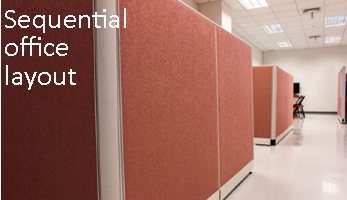

A sequential team at work is
like a baseball team. It can have workers in cubicles waiting for
someone to throw work over the wall. It is essential that each team
member do his or her job error free because each person does a
specialized part of the total work. The project manager spends a
great deal of time sequencing and scheduling work to assure the
right resources are available at the right time. People do their
assigned work and nothing more. They never step out of their
respective roles. It is not important for them to like each other,
nor do they need to interact face-to-face, as long as the work gets
done. The sequential team is well suited for waterfall projects.
A more random team at work is
like a basketball team. Team members need to interact directly,
preferably in the same space at the same time. The open office
layout promotes this. Roles and responsibilities may be defined,
but opportunities may arise for people to step out of their roles
and do what needs to be done. The random team is well suited for
agile projects.
Can we do the additive
process and take the best of each team structure, regardless of
project type? The Gallop organization did a survey to find out the
effects of telecommuting on employee engagement, or the opposite,
employee disengagement. Engaged employees tend to be more
productive than disengaged employees. Gallop found that the maximum
engagement and minimum disengagement happened when employees spent
some time in the office and some time telecommuting. This provides
evidence that we need some of both. Some of our work is sequential
and can be done anywhere. Some of our work is more random and is
best done face-to-face, interacting with the whole team.
Complete details - Big picture strategy
Agile and waterfall projects
both require planning, but they require different types of
planning. With waterfall there is detailed planning followed by
signoff. The detailed plan is the primary monitoring and
controlling mechanism. If it is in the plan it must happen and if
it is not in the plan it must not happen. Agile projects have a
general big picture plan, and a bunch of user stories. The user
stories are on the wall or in a database, but they remain
un-prioritized until it is time to prioritize them for the next work
effort. At that point the top priority user stories are built out
into greater detail and the work gets done.
Agile teams include the
product owners who have great influence on the priority. The work
team also helps sets the priority because some things are best
accomplished before other things. There is a bit of chaos in the
process, but from chaos, order can emerge.
Waterfall people might
question the value of chaos and wonder if it can work. The big
picture plan defines the overall project and the focus remains on
accomplishing that objective. The example I gave from my experience
with continuous planning demonstrates that it is an effective way of
giving product owners what they need now, rather than what senior
management decided they needed a year ago. If senior management sets
an overall budget and overall time constraint, the team can figure
out how to get there effectively.
Lessons learned - Retrospective
 One
of the final steps of a waterfall project is the lessons learned
session. It is supposed to serve as a mechanism for making future
projects more efficient. Often, it becomes a paper document that
will never again see the light of day. The team is ready to move on
and nothing from lessons learned will help the current project
because it is too late for that. When I hear the term, ďlessons
learned,Ē I feel like I am back in school and the teacher is
scolding us, ďI hope you learned your lesson.Ē One
of the final steps of a waterfall project is the lessons learned
session. It is supposed to serve as a mechanism for making future
projects more efficient. Often, it becomes a paper document that
will never again see the light of day. The team is ready to move on
and nothing from lessons learned will help the current project
because it is too late for that. When I hear the term, ďlessons
learned,Ē I feel like I am back in school and the teacher is
scolding us, ďI hope you learned your lesson.Ē
In the agile world, there are
many deliveries and many opportunities for learning. One of the
agile principles is to take time at regular intervals to reflect on
how things are going and look for opportunities to enhance the
teamís effectiveness. This is commonly called a retrospective and
is commonly not documented because it is a chance for the team to do
some honest reflection rather than trying to look good for
management. By removing the formality, it opens up discussion and
problem solving.
Can any team do both? Every
team should do both regardless of the type of project. The
retrospective is for the benefit of the team and the lessons learned
is for the benefit of the larger organization.
When we looked at Gragorcís
definition of the random and sequential styles, we were focusing on
how work gets done. Gregorc called this the
concrete/random and
concrete/sequential styles. He also
looked at this continuum from an abstract, non-physical standpoint.
How do people think, and how do people feel? This he called
abstract/random and
abstract/sequential. The
abstract/sequential style people prefer
logic, analysis, knowledge, facts, and documentation. In the
abstract/random style people think in
emotions, relationships, and memories. The highest priority for an
agile team is to satisfy the customer. This is an emotional
objective. In contrast, the waterfall effort at stakeholder
management is a logical and rational objective with a focus on
knowledge, facts and documentation.
User stories are preferred by
the
abstract/random style because of the
customer focus. User stories allow room for emotion and happiness
due to the flexibility and explanation on why something is needed.
Traditional requirements fit
the needs of the
abstract/sequential style. They focus on
logic, facts and documentation, taking the emotions out.
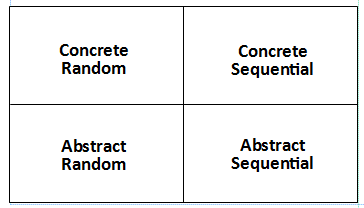 Gregorc
can be seen as a four-quadrant style profile, drawn here with the
concrete-abstract continuum, on the
vertical axis and the
random-sequential continuum on the
horizontal axis. This should not be confused with other
four-quadrant models that look at different behavioral
characteristics. The thing to learn from Gregorcís model is that it
is predictable that people will have preferences for the project
methods that meet the needs of their styles. Some people will
never be comfortable with methods that donít meet their needs.
Whether you go waterfall or agile, some people are going to have to
compromise. Gregorc
can be seen as a four-quadrant style profile, drawn here with the
concrete-abstract continuum, on the
vertical axis and the
random-sequential continuum on the
horizontal axis. This should not be confused with other
four-quadrant models that look at different behavioral
characteristics. The thing to learn from Gregorcís model is that it
is predictable that people will have preferences for the project
methods that meet the needs of their styles. Some people will
never be comfortable with methods that donít meet their needs.
Whether you go waterfall or agile, some people are going to have to
compromise.
Concrete/Random
∑ Instinctive,
intuitive, impulsive, independent.
∑ Now:
total of the past, interactive present, and seed for the future.
Concrete/Sequential
∑ Instinctive,
methodical, deliberate, structured.
∑ Discrete
units of past, present, and future.
Abstract/Random
∑ Emotional,
perceptive, critical.
∑ The
moment, time is artificial and restrictive.
Abstract/Sequential
∑ Logical,
analytical, rational, intellectual.
∑ Present,
historical past, and projected future.
This takes us to the end.
The goal of waterfall is to meet all three triple constraints.
Achieving that is difficult. Consequently a large number of
projects fail to be on time, on budget, with full scope. Agile
takes a more realistic view by prioritizing scope rather than
promising it all at once. Typically time and cost are locked in and
the team delivers what it can within these constraints. It is
important to deliver a minimum viable product early in the time
schedule so that the customer has something working in production,
even if the rest cannot be completed. Once the minimum viable
product is in place, the product owners can decide when to end the
project. If they are satisfied with progress, they might keep the
project going by giving it more time and more budget to get more
scope.

It is decision time. What
are you going to do? The zero-sum way is to follow best practices
for your preferred method. The non-zero sum way is to learn from a
negotiation method where you try to figure out what each party
really wants, and what each party will minimally accept. This
defines the range of acceptability, which is the area up for
negotiation. It is also known as the area where there is a win/win
solution. If you take a blended approach, you will not be following
best practices for either approach. But
you can follow
good practices from each.
If you know what you want and
it has been done before, then creativity and innovation are not
needed or wanted. Best practice waterfall might be the best
choice. On the other hand, if it is entirely new, innovation and
creativity are essential so best practice agile might be the be the
best choice. Most projects are somewhere in the middle.
As a final thought, go back
to the first statement in the Agile Manifesto,
Individuals and interactions over processes and tools.
Regardless of your methodology, it is people who
do the work. If you donít pay attention to the people, the rest
does not matter.
Sources:
Sidhu,
Inder
(2010),
Doing
Both: How Cisco Captures Today's Profit and Drives Tomorrow's Growth,
FT Press
Lyons,
Dan (2016),
Disrupted, My Misadventure in the Start-Up Bubble,
Hachette Books
Gregorc,
Anthony
(1982),
An Adult's Guide to Style,
Columbia, CT: Gregorc Associates, Inc.
Agile definition: https://www.merriam-webster.com/dictionary/agile
Middle French, from Latin agilis, from agere to
drive, act , First Known Use: 1581
Agile Manifesto http://agilemanifesto.org/
© 2001, the above authors this declaration may be freely copied in
any form, but only in its entirety through this notice.
Can People Collaborate While Working Remotely?
Gallup Business
Journal March 13, 2014
Coxswain
definition: https://en.wikipedia.org/wiki/Coxswain_(rowing)
Requirements,
user stories, RACI:
International Institute of Business Analysis (IIBA), Business
Analysis Body of Knowledge (BABOK) version 3.0 © 2015
Hubspot 2014 losses:
http://venturebeat.com/2014/08/25/hubspot-files-to-go-public-with-a-100m-ipo/
Hubspot 2016 losses:
http://amigobulls.com/stocks/HUBS/income-statement/quarterly
Waterfall definition: https://quizlet.com/38088105/kpmg-flash-cards/
PMBOK: ©2013 Project Management Institute,
Inc. All rights reserved
Zero Sum definition: http://lawprofessors.typepad.com/environmental_law/2016/12/elc-essay-2-the-zen-of-nonzerosumness-in-environmental-policy-easier-to-say-than-to-achieve.html
Steve Wille is an experienced information
technology executive having worked for large corporations in many
roles including software development, project manger, director of
application development, vice president of corporate information
systems, and senior vice president of a business division.
His book, Colorful
Leadership, focuses on three perspectives
of project management, people, process, and innovation. He has
written and facilitated workshops on project management, business
analysis, high performance project teams, and constructive conflict.
Steve is active in the
Colorado IT community as a board member of SIM (Society for
Information Management, president of RMIMA (Rocky Mountain
Information Management Association), and an active member of Mile
High PMI (Project Management Institute). He serves on the Regis
University IT advisory board. His MBA is from Regis University and
his BSBA is from the University of Denver.
Michael Wille is an experienced developer
and agile coach. His BS degree is from Colorado State University.
After freelancing software development, he entered the corporate
world and found his place in the space between traditional project
management and agile project management. He is a Certified Scrum
Master (CSM) and a Project Management Professional (PMP) |
